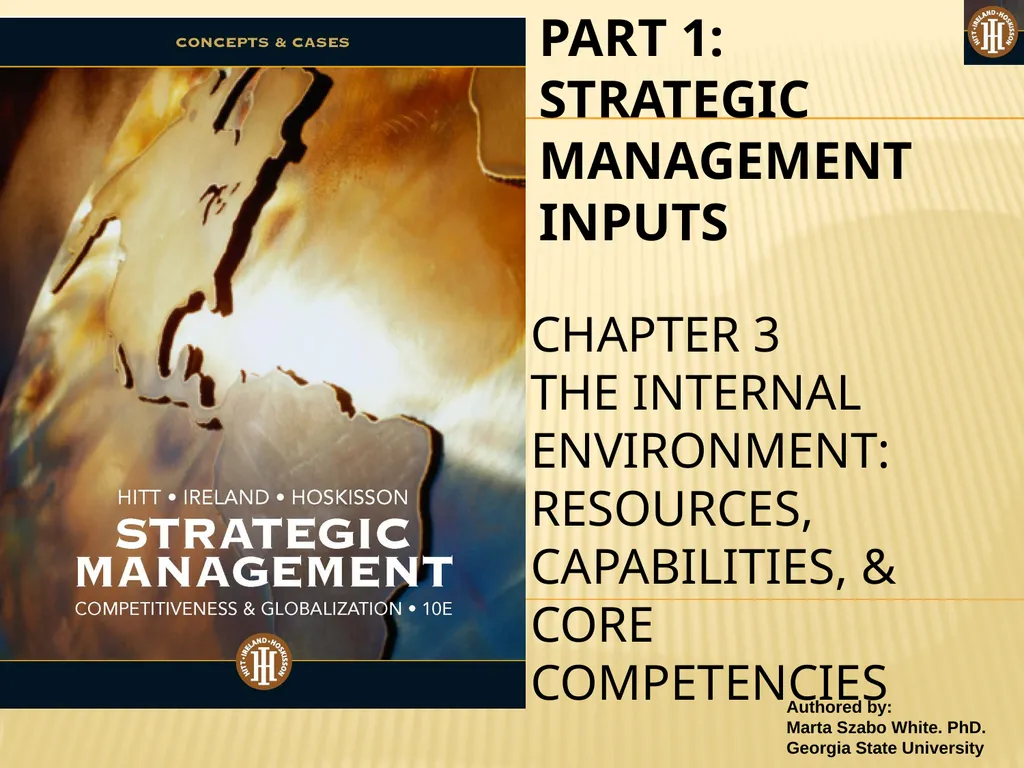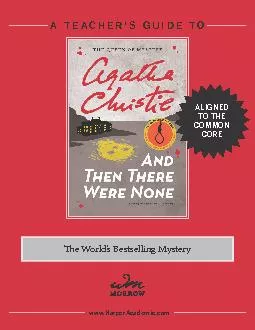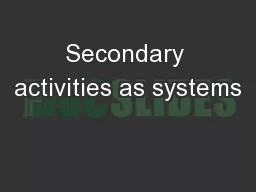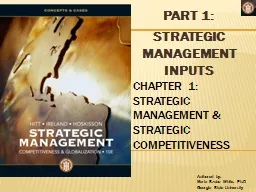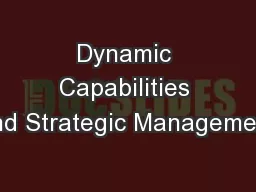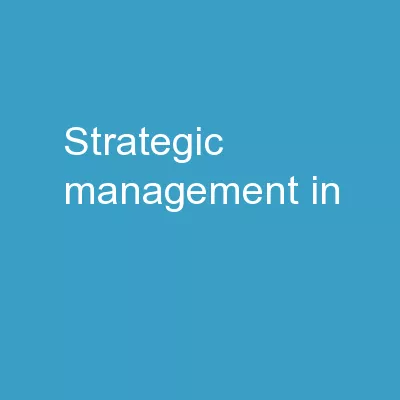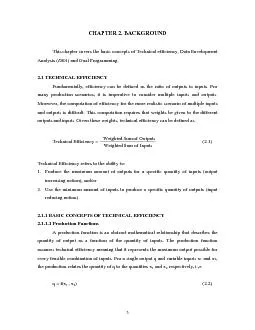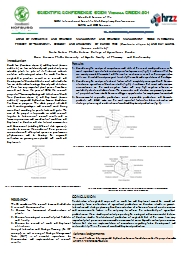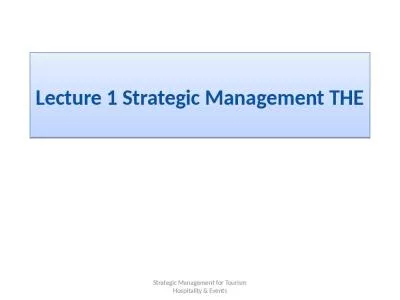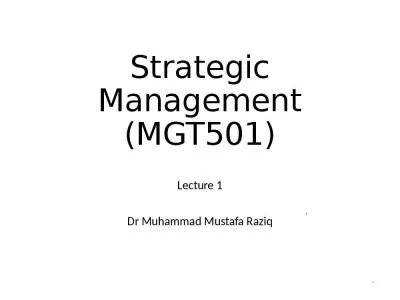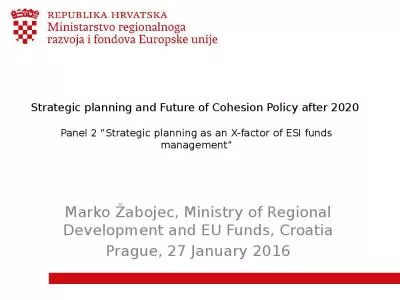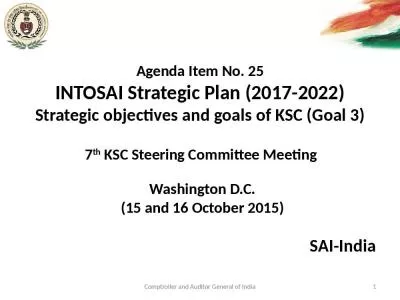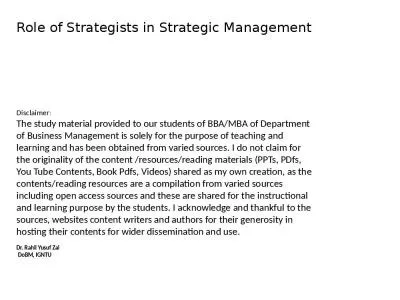PART 1: STRATEGIC MANAGEMENT INPUTS CHAPTER 3 THE
Author : trish-goza | Published Date : 2025-06-23
Description: PART 1 STRATEGIC MANAGEMENT INPUTS CHAPTER 3 THE INTERNAL ENVIRONMENT RESOURCES CAPABILITIES CORE COMPETENCIES THE STRATEGIC MANAGEMENT PROCESS KNOWLEDGE OBJECTIVES KNOWLEDGE OBJECTIVES OPENING CASE SUBWAY RESTAURANTS CORE
Presentation Embed Code
Download Presentation
Download
Presentation The PPT/PDF document
"PART 1: STRATEGIC MANAGEMENT INPUTS CHAPTER 3 THE" is the property of its rightful owner.
Permission is granted to download and print the materials on this website for personal, non-commercial use only,
and to display it on your personal computer provided you do not modify the materials and that you retain all
copyright notices contained in the materials. By downloading content from our website, you accept the terms of
this agreement.
Transcript:PART 1: STRATEGIC MANAGEMENT INPUTS CHAPTER 3 THE:
PART 1: STRATEGIC MANAGEMENT INPUTS CHAPTER 3 THE INTERNAL ENVIRONMENT: RESOURCES, CAPABILITIES, & CORE COMPETENCIES THE STRATEGIC MANAGEMENT PROCESS KNOWLEDGE OBJECTIVES KNOWLEDGE OBJECTIVES OPENING CASE SUBWAY RESTAURANTS: CORE COMPETENCIES AS THE FOUNDATION FOR SUCCESS 1965: Subway opened its first shop Current portfolio of almost 35,000 units located in 98 countries More store locations than McDonald’s Subway’s focus on “Eat Fresh,” high-quality foods, continuous training, customer service, and “non-traditional” store locations illustrate Subway’s core competencies and the foundation for competitive advantage, underscoring key chapter concepts EXTERNAL ANALYSES’ OUTCOMES Opportunities and Threats By studying the external environment, firms identify what they MIGHT CHOOSE TO DO INTERNAL ANALYSES’ OUTCOMES Unique Resources, Capabilities, and Competencies (required for sustainable competitive advantage) By studying the internal environment, firms identify what they CAN DO MATCHES STRATEGIC COMPETITIVENESS AND ABOVE-AVERAGE RETURNS RESULT WHEN: ©2013 Cengage Learning. All Rights Reserved. May not be copied, scanned, or duplicated, in whole or in part, except for use as permitted in a license distributed with a certain product or service or otherwise on a password-protected website for classroom use. COMPETITIVE ADVANTAGE KEY POINTS ■ No competitive advantage lasts forever ■ Over time, rivals use their own unique resources, capabilities, and core competencies to duplicate the focal firm’s ability to create value for customers ■ With globalization, sustainable competitive advantage is especially challenging COMPETITIVE ADVANTAGE KEY POINTS ■ Firms must exploit their current advantages while simultaneously using their resources and capabilities to form new advantages that can lead to future competitive success ■ INNOVATION and PEOPLE are critical resources for organizations in their quest for competitive advantage COMPETITIVE ADVANTAGE SUSTAINABILITY Sustainability of a competitive advantage is a function of: The rate of core competence obsolescence due to environmental changes The availability of substitutes for the core competence The imitability of the core competence ANALYZING THE INTERNAL ORGANIZATION The Context of Internal Analysis Global Economy Traditional sources of advantages can be overcome by competitors’ international strategies and by the flow of resources throughout the global economy Global Mindset The ability to study an internal environment in ways that are not dependent on the assumptions of a single country, culture, or context Analysis Outcome Understanding how to leverage the firm’s bundle of heterogeneous resources and capabilities COMPETITIVE ADVANTAGE Components of Internal Analysis Leading to Competitive Advantage and Strategic Competitiveness FIGURE 3.1 Components of an Internal Analysis ANALYZING THE INTERNAL ORGANIZATION Creating Value By innovatively bundling
